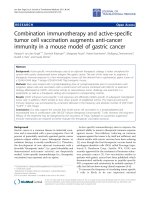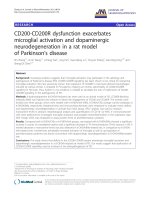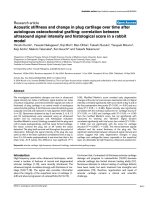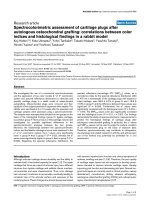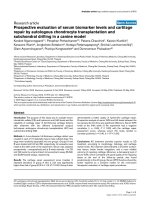Role of central nervous system ceramides and free radicals in a mouse model of orofacial pain
Bạn đang xem bản rút gọn của tài liệu. Xem và tải ngay bản đầy đủ của tài liệu tại đây (965.7 KB, 178 trang )
Role of Central Nervous System Ceramides and Free Radicals
in a Mouse Model of Orofacial Pain
Tang
Ning
(MBBS)
Supervisor: Associate Professor Yeo Jin Fei
A THESIS SUBMITTED FOR THE DEGREE OF
DOCTOR OF PHILOSOPHY
DEPARTMENT OF ORAL AND MAXILLOFACIAL SURGERY
FACULTY OF DENTISTRY
NATIONAL UNIVERSITY OF SINGAPORE
2009
Acknowledgments
I
ACKNOWLEDGMENTS
First of all, I would like to express my deepest appreciation to my two
supervisors, Associate Professor Yeo Jin Fei (Department of Oral and Maxillofacial
Surgery, Faculty of Dentistry) and Associate Professor Ong Wei Yi (Department of
Anatomy, Yong Loo Lin School of Medicine). Their guidance, support, and generosity
have made me where I am today. They have not only introduced me to an entirely new
research field but also are role models for hardworking and commitment to research.
Their deep and sustained interest, immense patience and stimulating discussions have
been most invaluable in the accomplishment of my research project.
I must also acknowledge my gratitude to Assistant Professor Chen Peng and Dr
Zhang En Ming from Division of Bioengineering, Nanyang Technological University,
Dr Wei Shun Hui from Singapore Bioimaging Consortium, Biopolis, for their kind
suggestions and guidance in my work.
I would like to thank all other staff members, my fellow postgraduate students and
vital friends in Histology Lab, Neurobiology Programme, Centre for Life Science,
National University of Singapore: Pan Ning, Lim Seok Wei, Jinatta Jittiwat, Lee Li
Yen, Lee Hui Wen Lynette, Kim Ji Hyun, Ma May Thu, Poh Kay Wee, Chia Wan
Jie, for their help and support in many ways. It was a joyful experience working with all
of them.
Acknowledgments
II
Last but not least, I would like to take this opportunity to express my heartfelt
thanks to my family for their full and endless support, especially my husband, Dr He
Wei, whose constant encouragement and understanding throughout my study have made
this work possible, and to my child, He Ming Zhe who brings me so much joy. Without
my family, I could not have completed this thesis.
Table of Contents
III
TABLE OF CONTENTS
ACKNOWLEDGEMENTS …………………………………… …… ………………. I
TABLE OF CONTENTS………………………………….……………… …………. .III
SUMMARY…………………………………………………….…………… … VIII
LIST OF TABLES………………………………………………………………… X
LIST OF FIGURES…………………………………………………………… … XI
ABBREVIATIONS…………………………………………………… … …………XIII
PUBLICATIONS……………………………….…………… ……….…… …… XVI
Chapter I Introduction 1
1. General introduction of pain 2
1.1. History of pain study and pain definitions 2
1.2. Types of pain 4
1.2.1. Type 1 (Acute nociceptive pain) 4
1.2.2. Type 2 (Inflammatory pain) 4
1.2.3. Type 3 (Neuropathic pain) 5
1.3. Primary and central sensitization 6
1.3.1. Peripheral sensitization 6
1.3.2. Central sensitization 8
2. General introduction of orofacial pain 10
2.1. Anatomy basis of orofacial pain 10
2.1.1. Trigeminal nerves 10
2.1.2 Trigeminal ganglion 11
2.1.3. Sensory trigeminal nucleus 12
2.1.4. Pathways to the thalamus and the cortex 15
Table of Contents
IV
2.2. Orofacial pain 16
2.3. Animal model of orofacial pain 17
3. General introduction of sphingolipids 21
3.1. Structure and classification of sphingolipids 21
3.2. Biosynthesis of sphingolipids 22
3.3. Biological effects of sphingolipids 24
3.3.1. Sphingolipids as second messengers 26
3.3.2. Sphingolipids affect Ca
2+
mobilization in neural cells 27
3.3.3. Sphingolipids affect excitability and neurotransmitter release 28
3.4. Biological and biophysical effects of ceramides 29
3.5. Sphingolipids in pain perception 31
4. Role of free radicals in nociception 33
4.1. Role of nitric oxide in nociception 33
4.2. Role of superoxide in nociception 35
4.3. Role of peroxynitrite in nociception 36
4.4. Interaction between sphingolipids and ROS/RNS 38
4.4.1. Regulation of sphingolipid metabolism by oxidative stress 38
4.4.2. Regulation of redox potential by sphingolipids 39
Chapter II Aims of the present study 40
Chapter III Experimental studies 43
Chapter 3.1 Possible effects of CNS ceramides on allodynia induced by facial
carrageenan injection 44
1. Introduction 45
Table of Contents
V
2. Materials and methods 47
2.1 Behavioral experiment 47
2.1.1. Animal groups and chemicals 47
2.1.2. Behavioral assessment 49
2.1.3. Intracerebroventricular injection 51
2.1.4. Facial carrageenan injection 51
2.2. ASMase activity assay and PC-PLC activity assay 52
2.2.1. Animals and tissue harvesting 52
2.2.2. Enzyme activity assay 52
2.3. The effect of free radical spin trap phenyl-N-tert-butylnitrone (PBN) on facial
allodynia 54
2.4. Intracellular H
2
O
2
production in PC12 cells induced by ceramides 55
2.4.1. Cells and chemicals 55
2.4.2. H
2
O
2
assay in PC12 cells 56
3. Results 58
3.1. Behavioral experiment 58
3.1.1. Effects of vehicle controls on facial carrageenan injected mice 58
3.1.2. Effects of ASMase inhibitors on carrageenan injected mice 60
3.1.3. Effect of NSMase inhibitor on carrageenan injected mice 63
3.1.4. Effect of SPT inhibitor on carrageenan injected mice 63
3.1.5. Effects of ICV injection of inhibitors on mice without carrageenan injection 66
3.2. ASMase activity and PC-PLC activity assay after ICV D609 injection 67
3.3. Effect of free radical scavenger PBN on facial allodynia 69
3.4. Intracellular H
2
O
2
production induced by C18 ceramide in PC12 cells 70
4. Discussion 73
Chapter 3.2 Effects of ceramides on exocytosis and intracellular calcium concentration 77
Table of Contents
VI
1. Introduction 78
2. Materials and methods 80
2.1. Cell membrane capacitance measurements 80
2.1.1. Cell culture 80
2.1.2. Lipid raft disruption by methyl ß cyclodextrin 81
2.1.3. Solutions for patch clamp recording 82
2.1.4. Whole-cell patch clamp recording 82
2.2. Total internal reflection fluorescence microscopy (TIRFM) 84
2.2.1. Cells and plasmids 84
2.2.2. TIRFM 85
2.3. Intracellular free calcium level measurement 85
2.3.1. Cell culture 85
2.3.2. Intracellular calcium concentration measurements 86
3. Results 87
3.1. Capacitance measurements 87
3.1.1. Capacitance changes after adding ceramides to PC12 cells 87
3.1.2. Capacitance changes after adding C18 ceramide to PC12 cells depleted of
membrane cholesterol 91
3.1.3. Capacitance changes after adding C18 ceramide to primary hippocampal
neurons 92
3.2. TIRFM 93
3.3. C18 ceramide’s effect on [Ca
2+
]
i
in PC12 cells 95
4. Discussion 96
Chapter 3.3 Role of central nervous system peroxynitrite in a mouse model of orofacial
pain 99
1. Introduction 100
2. Materials and methods 102
Table of Contents
VII
2.1. Chemicals 102
2.2. Animals and treatment 102
2.3. von Frey hair stimulation 104
2.4. ICV injections and facial carrageenan injections 104
3. Results 105
3.1. Effect of facial carrageenan injection on control groups 105
3.2. Effect of ONOO
-
scavenger on carrageenan injected mice 106
3.3. Effect of ONOO
-
donor on carrageenan injected mice 108
3.4. Effect of ONOO
-
donor or ONOO
-
scavenger on mice without carrageenan
injection 110
3.5. Effect of the co-injection of the donor and scavenger of ONOO
-
on facial
carrageenan injected mice 111
4. Discussion 112
Chapter IV Conclusions 114
Chapter V References 123
Summary
VIII
SUMMARY
Growing evidences have indicated an important role of central nervous system
(CNS) lipid mediators and reactive nitrogen species (RNS) in augmenting the sensitivity
of sensory neurons and enhancing pain perception. Increased amount of ceramide which
is an important sphingolipid signaling molecule and elevated ceramide biosynthetic
activity have been shown to contribute to neuronal death in the hippocampus after
kainate-induced excitotoxic injury. RNS species such as peroxynitrite (ONOO
-
) and its
derivates can cause lipid oxidation, protein nitration, and DNA damage, leading to
changes in the function of signaling molecules.
Intracerebroventricular (ICV) injection of inhibitors to ceramide synthetic
enzymes into mice was conducted to elucidate possible role of CNS ceramide in orofacial
pain induced by facial carrageenan injection. ICV injection of inhibitors to acid
sphingomyelinase (ASMase), neutral sphingomyelinase (NSMase), or serine
palmitoyltransferase (SPT) significantly reduced allodynic responses in facial
carrageenan injected mice.
An enzyme activity assay was conducted in the mice brain tissue. Increased
ASMase activity was found in the left primary somatosensory cortex at 3 days after facial
carrageenan injection. And ICV injection of ASMase inhibitor D609 significantly
reduced ASMase activity in all parts of brain examined (i.e., left and right brain stem,
thalamus, and primary somatosensory cortex). These results provide a further
confirmation that D609 alleviates facial allodynia through the action of ASMase.
Summary
IX
Since D609 is also found to be a free radical scavenger,
phenyl-N-tert-butylnitrone (PBN), a free radical spin trap was ICV injected to elucidate
the role of free radicals in nociception. Similar anti-allodynic effect was observed in mice
with facial allodynia after PBN treatment. It was also found that C18 ceramide could
cause increased hydrogen peroxide production in PC12 cells. This effect could be
inhibited by co-treatment with L-type calcium inhibitor (nifedipine), free radical
scavengers (D609 or PBN), or mitochondria permeability transition pore blockers
(bongkrekic acid or cyclosporine A).
Electrophysiological study showed that ceramide has the ability to directly induce
exocytosis in cells using membrane capacitance measurement technique (whole-cell
patch clamp) and total internal reflection fluorescence microscopy technique. Effects of
ceramide were found to be dependent on the integrity of cell membrane lipid raft, as
ceramide could not induce exocytosis in cells depleted of membrane cholesterol. Direct
application of ceramide can also cause elevated intracellular calcium concentration in
PC12 cells.
The role of other forms of free radicals such as peroxynitrite in orofacial allodynia
was also investigated. Mice behavioral studies showed that ONOO
-
plays a role in
nociception in the CNS in mice with facial allodynia. ICV injection of ONOO
-
scavenger
FeTPPS significantly reduced allodynia in the facial carrageenan injected mice at 3 days
after injection.
In conclusion, the present study showed a possible role of CNS ceramide and
ONOO
-
in a mouse model of orofacial allodynia.
List of Tables
X
LIST OF TABLES
Table 3.1 Treatment groups of Balb/c mice 47
Table 3.2 Chemicals used in H
2
O
2
assay. 56
Table 3.3 Number of face wash strokes in control groups 59
Table 3.4 Number of face wash strokes after D609 plus carrageenan injection. 61
Table 3.5 Number of face wash strokes after PtdIns3,5P
2
plus carrageenan injection. 62
Table 3.6 Number of face wash strokes after GW4869 plus carrageenan injection. 64
Table 3.7 Number of face wash strokes after L-cycloserine or myriocin plus carrageenan
injection. 66
Table 3.8 Number of face wash strokes in mice without facial carrageenan injection. 67
Table 3.9 Number of face wash strokes after PBN injection. 70
Table 3.10 Ceramide species used in patch clamp and TIRFM experiment. 80
Table 3.11 Effect of ceramide species on exocytosis in PC12 cells. 90
Table 3.12 Effect of C18 ceramide on exocytosis in primary hippocampal neurons. 93
Table 3.13 Comparison of numbers of subplasmalemmal vesicles in PC12 cells after
external application of different ceramide species. 95
Table 3.14 Treatment group of C57BL/6J mice. 103
Table 3.15 Number of face wash strokes after FeTPPs plus carrageenan injection. 108
Table 3.16 Number of face wash strokes after SIN-1 plus carrageenan injection. 109
Table 3.17 Number of face wash strokes after SIN-1/ FeTPPs injection in mice without
facial carrageenan injection. 110
Table 3.18 Number of face wash strokes after co-injection of SIN-1 and FeTPPs in facial
carrageenan injected mice 111
List of Figures
XI
LIST OF FIGURES
Figure 1.1 Diagram illustrating the changes in pain sensation induced by injury 5
Figure 1.2 Dermatome distribution of the trigeminal nerve 11
Figure 1.3 Distribution of sensory trigeminal nucleus. 13
Figure 1.4 Responses of different mouse strains to different behavioral measures of
nociception 18
Figure 1.5 General chemical structures of sphingolipids 21
Figure 1.6 Structure of C2 ceramide and C18:1 ceramide. 22
Figure 1.7 Biosynthesis of sphingolipids 23
Figure 1.8 Peroxynitrite-mediated tyrosine nitration plays a key role in inflammation and
pain. 37
Figure 3.1 Effect of vehicle controls on facial allodynia in mice. 59
Figure 3.2 Effect of ASMase inhibitor D609 on facial allodynia in mice. 61
Figure 3.3 Effect of ASMase inhibitor PtdIns3,5P
2
on facial allodynia in mice. 62
Figure 3.4 Effect of NSMase inhibitor GW4869 on facial allodynia in mice. 64
Figure 3.5 Effect of SPT inhibitor L-cycloserine and myriocin on facial allodynia in mice.
65
Figure 3.6 ASMase and PC-PLC activity in different parts of brain. 68
Figure 3.7 Effect of free radical scavenger PBN on carrageenan induced facial allodynia.
69
Figure 3.8 C18 ceramide’s effects on intracellular H
2
O
2
production in PC12 cells 71
Figure 3.9 C18 ceramide’s effects on intracellular H
2
O
2
production are affected by other
factors 72
Figure 3.10 Typical recording of capacitance changes after addition of C18 ceramide to
PC12 cells. 88
Figure 3.11 Membrane capacitance changes after adding different ceramide species to
PC12 cells. 89
List of Figures
XII
Figure 3.12 Effect of C18 ceramide on membrane capacitance in methyl ß cyclodextrin
pre-treated PC12 cells. 91
Figure 3.13 Effect of methyl β cyclodextrin on membrane capacitance changes in neurons.
92
Figure 3.14. Time-lapse total internal reflection fluorescence microscopy (TIRFM) after
application of ceramide species. 94
Figure 3.15 Changes of intracellular calcium level after addition of C18 ceramide to
PC12 cells. 96
Figure 3.16 Effect of facial carrageenan injection on control groups. 106
Figure 3.17 Effect of ONOO
-
scavenger on carrageenan induced facial allodynia. 107
Figure 3.18 Effect of ONOO
-
donor on carrageenan induced facial allodynia 109
Figure 4.1 Flow chart of the experimental design and main findings of the present study
116
Figure 4.2 Hypothetical diagram showing interplay and cross-talk between
glycerophospholipid- and sphingolipid-derived lipid mediators along with oxidative
stress 119
Abbreviations
XIII
ABBREVIATIONS
[Ca
2+
]
i
intracellular free calcium concentration
5-HT serotonin/5-hydroxytryptamine
AMPA α-amino-3-hydroxyl-5-methyl-4-isoxazole-propionate
ASMase acid sphingomyelinase
ATP adenosine triphosphate
cAMP cyclic adenosine monophosphate
Cer1P ceramide 1- phosphate
cGMP cyclic guanosine monophosphate
CGRP calcitonin gene related peptide
CNS central nervous system
COX cyclooxygenase
cPLA
2
cytosolic phospholipase A
2
DAG diacylglycerol
DMEM Dulbecco’s modified eagle medium
DMSO dimethyl sulfoxide
DRG dorsal root ganglia
EDTA ethylenediaminetetraacetic acid
EGFP enhanced green fluorescence protein
EGTA ethylene glycol tetraacetic acid
eNOS endothelial nitric oxide synthase
Fura-2-AM Fura-2, acetoxymethyl ester
H
2
O
2
hydrogen peroxide
Abbreviations
XIV
IASP International association for the study of pain
IC50 median inhibition concentration
ICV intracerebroventricular
iNOS inducible nitric oxide synthase
IP intraperitoneal
IP
3
inositol trisphosphate
KRPG Krebs–Ringer phosphate buffer
M-ß-CD methyl ß cyclodextrin
mtNOS mitochondrial nitric oxide synthase
NGF nerve growth factor
NMDA N-methyl-D-aspartate
nNOS neuronal nitric oxide synthase
NO nitric oxide
NOS nitric oxide synthase
NPY neuropeptide Y
NSMase neutral sphingomyelinase
O
2
-
super oxide anion
ONOO
-
peroxynitrite
PBN phenyl-N-tert-butylnitrone
PC-PLC phosphatidylcholine-specific phospholipase C
PC12 cell pheochromocytoma cell
PGE
2
prostaglandin E
2
PKC protein kinase C
Abbreviations
XV
PLA
2
phospholipase A
2
Pr5 the principal or main trigeminal nucleus
RNS reactive nitrogen species
ROS reactive oxygen species
S1P sphingosine 1- phosphate
SI primary somatosensory cortex
SII secondary somatosensory cortex
SNARE soluble N-ethylmaleimide-sensitive factor attachment protein receptor
SOD superoxide dismutase
Sp5C spinal trigeminal nucleus caudalis
Sp5I spinal trigeminal nucleus interpolaris
Sp5O spinal trigeminal nucleus oralis
sPLA
2
secretory phospholipase A
2
SPT serine palmitoyltransferase
SPTLC1 serine palmitoyltransferase, long chain base subunit 1
TIRFM total internal reflection fluorescence microscopy
TNF tumor necrosis factor
TRPV1 transient receptor potential cation channel, subfamily V, member 1
UV ultraviolet
VPL ventral posterolateral nucleus of the thalamus
VPM ventral posteromedial nucleus of the thalamus
Publications
XVI
PUBLICATIONS
Various portions of the present study have been published in international
refereed journals.
1. Tang N, Ong WY, Farooqui AA, Yeo JF (2009) Anti-allodynic effect of
intracerebroventricularly administered antioxidant and free radical scavenger in a mouse
model of orofacial pain. J Orofac Pain 23: 167-173
2. Yeo JF, Ling SF, Tang N, Ong WY (2008) Antinociceptive effect of CNS
peroxynitrite scavenger in a mouse model of orofacial pain. Exp Brain Res 184: 435-438
3. Tang N, Ong WY, Zhang EM, Chen P, Yeo JF (2007) Differential effects of ceramide
species on exocytosis in rat PC12 cells. Exp Brain Res 183: 241-247
4. Ong WL, Jiang B, Tang N, Ling SF, Yeo JF, Wei S, Farooqui AA, Ong WY (2006)
Differential effects of polyunsaturated fatty acids on membrane capacitance and
exocytosis in rat pheochromocytoma-12 cells. Neurochem Res 31: 41-48
Chapter I Introduction
1
Chapter I
INTRODUCTION
Chapter I Introduction
2
1. General introduction of pain
1.1. History of pain study and pain definitions
Pain is defined by the International Association for the Study of Pain (IASP, 2008)
as “an unpleasant sensory and emotional experience associated with actual or potential
tissue damage, or describe in terms of such damage”. It is a protective mechanism for the
body and causes a human or animal to take action to remove the pain stimulus.
The earliest scientific history of pain transmission should be René Descartes'
reflex theory more than 300 years ago, which proposed a specific pain pathway which
carries the information from pain receptors in the peripheral skin to pain center in the
brain, indicating that a simple block of the pathway would result in the alleviation of pain.
The pain measurement at that time was focused on the pain intensity. Descartes’ reflex
theory guided both the study and treatment of pain for centuries till the appearance of the
gate control theory of pain (Melzack and Wall 1965), which led to a further investigation
into spinal sensitization and central nervous system (CNS) plasticity. The main
achievement of the gate control theory of pain is that it led to the recognition that the
relationship between pain and stimulus is not a simple sensory response, the processing
of pain takes place in at least three levels — at peripheral, spinal, and supraspinal sites.
However, recently more studies showed that pain perception is not a mere biophysical
process, it is always subjective and influenced by a variety of complicated factors. For
example, acute pain can be proportional to the extent of the injury, but also be affected by
psychological factors, such as fear, anxiety, cultural background and the meaning of the
situation to the person (Sternbach 1975).
Chapter I Introduction
3
A few definitions of pain-related terms are clarified here: Nociception is defined
as the neural process of encoding and processing noxious stimuli (Loeser and Treede
2008). It is the afferent activity produced in the peripheral and CNS by stimuli that have
the potential to damage tissue. The term “nociception” is often used interchangeably with
the term “pain”, but technically refers to the transmission of nociceptive information to
the brain without reference to the production of emotional or other types of response to
the noxious stimulus. Nociceptor is a receptor preferentially sensitive to a noxious
stimulus or to a stimulus which would become noxious if prolonged. The most often used
two behavioral tests in pain studies are hyperalgesia and allodynia. Hyperalgesia is the
increased response to a stimulus which is normally painful. For pain evoked by stimuli
that usually are not painful, the term allodynia is preferred. Allodynia is defined as pain
due to a stimulus which does not normally provoke pain. In addition, the difference
between hyperalgesia and allodynia can also be elucidated in terms of pain
hypersensitivity which takes two forms: thresholds are lowered so that stimuli that would
normally not produce pain now begin to — allodynia; Responsiveness is increased, so
that noxious stimuli produce an exaggerated and prolonged pain — hyperalgesia.
Other somatosensory disorders of increased pain sensation which are often seen
in the literature include hyperesthesia, hyperpathia and neuropathy. Hyperesthesia is
defined as increased sensitivity to stimulation, excluding the special senses.
Hyperesthesia may refer to various modes of cutaneous sensibility including touch and
thermal sensation without pain, as well as to pain. Hyperesthesia includes both allodynia
and hyperalgesia. Hyperpathia is defined as a painful syndrome characterized by an
abnormally painful reaction to a stimulus, especially a repetitive stimulus, as well as an
Chapter I Introduction
4
increased threshold. Neuropathy is a disturbance of function or pathological change in a
nerve (IASP, 2008).
1.2. Types of pain
Depending on the nature and time course of the original stimulus, there are three
major types of pain that have different neurophysiological mechanisms. However, it is
important to know that these types are not exclusive.
1.2.1. Type 1 (Acute nociceptive pain)
The mechanism of type 1 of pain can be viewed as a simple and direct route of
transmission centrally toward the thalamus and cortex and subsequently the conscious
perception of pain, however there still has possibility of modulation at synaptic relays
along the pathway. It is suggested that it is best to use models based on the specificity
interpretation of pain mechanisms to explain type 1 pain, that is, the existence within the
peripheral and CNS of a series of neuronal elements concerned solely with the processing
of these simple noxious elements.
1.2.2. Type 2 (Inflammatory pain)
If a noxious stimulus is very intense or prolonged, leading to tissue damage and
inflammation, the afferent flow to the CNS from the injured nociceptors will increase
because of the elevated activity and responsiveness of sensitized nociceptors. And
nociceptive neurons in the spinal cord also modify their responsiveness in ways that are
not merely an expression of the peripheral stimulations.
The subject with type 2 pain can feel spontaneous pain in the injured area, as well
Chapter I Introduction
5
as the undamaged area surrounding the injury site. This changed sensation is known as
hyperalgesia, defined as a leftward shift in the stimulus-response function (Figure 1.1). In
this situation, normally innocuous stimuli such as brushing and touch, are painful
(allodynia), and normally mild pain stimuli like pinprick are much more painful than
usual (hyperalgesia). Hyperalgesia in the area of injury is also known as primary
hyperalgesia, and the abnormal pain in the “normal” tissue surrounding the damaged site
is defined as secondary hyperalgesia.
Figure 1.1 Diagram illustrating the changes in pain sensation induced by injury.
The normal relationship between stimulus intensity and magnitude of pain
sensation is represented by the curve. Pain sensation is only evoked by stimulus
intensities in the noxious range (the vertical dotted line indicates the pain
threshold). The leftward shift in the curve relating stimuli intensity to pain
sensation is called hyperalgesia. Under these conditions, innocuous stimuli
evoke pain (allodynia), and stimuli intensities that normally evoke mild pain
evoke more intense pain (Cervero and Laird 1996).
1.2.3. Type 3 (Neuropathic pain)
This type of pain is abnormal and is generally the consequence of damage to
peripheral nerves or CNS itself, characterized by a lack of correlation. These pains are
spontaneous, triggered by innocuous stimuli, or are exaggerated responses to noxious
Chapter I Introduction
6
minor stimuli. These sensations are expressions of substantial changes in the nociception
system induced by peripheral or central damages.
1.3. Primary and central sensitization
On the one hand, pain hypersensitivity as an adaptive response facilitates the
healing process after an injury because it avoids or minimizes the direct contact with the
injured tissue until repair is complete. On the other hand, pain hypersensitivity may
persist long after an injury has healed or occur in the absence of any injury. In this case,
pain turns to a manifestation of pathological change in the nervous system.
Two mechanisms are known to be involved in pain hypersensitivity — peripheral
and central sensitization. “Sensitization” here means the increase in the excitability of
neurons, so they are more sensitive to stimuli or sensory inputs.
1.3.1. Peripheral sensitization
Peripheral sensitization refers to a reduction in threshold and an increase in the
sensitivity and excitability of the nociceptors terminal (Treede et al. 1992; Julius and
Basbaum 2001). Peripheral sensitization contributes to pain hypersensitivity at the site of
tissue damage and inflammation, a phenomenon which is also called primary
hyperalgesia.
Peripheral sensitization results from the release of numerous inflammatory factors
and changes of ion channels in the nociceptor terminal. The inflammatory factors include
prostaglandins, adenosine triphosphate (ATP) (Gold et al. 1996), bradykinin (Chahl and
Iggo 1977; Cui and Nicol 1995), nerve growth factor (NGF), potassium, leukotrienes,
Chapter I Introduction
7
serotonins, substance P, histamines, thromboxanes, serotonin/5-hydroxytryptamine (5-HT)
(Cardenas et al. 2001; Okamoto et al. 2002), endothelin-1 (Gokin et al. 2001; Zhou et al.
2002), platelet-activating factor, protons and free radicals. For example, increased level
of substance P is found in the periphery after nerve injury (Donnerer et al. 1993; Carlton
et al. 1996). It has been observed that intrathecal injection of substance P, or its close
analogues, can produce hyperalgesia to a variety of noxious stimuli (Cridland and Henry
1986).
These inflammatory mediators could phosphorylate G-protein-coupled receptors
or tyrosine kinase receptors on nociceptor terminals, activating phospholipase C signaling
pathways. Among these receptors, transient receptor potential receptor (TRP) is the one
that has been well studied. TRPV1 (transient receptor potential receptor, subfamily V,
member 1) can be activated by noxious heat, acid, capsaicin and resiniferatoxin, leading
to burning pain or itch. It is found that NGF and bradykinin can induce changes in
TRPV1 by activating of cAMP-dependent (cyclic adenosine monophosphate-dependent)
protein kinase and Ca
2+
/phospholipid-dependent kinase, so that a lower temperature
(<40 °C) which normally could not activate TRPV1 can now activate this receptor
(Chuang et al. 2001).
Transcriptional or translational regulation also contributes to peripheral
sensitization. It is found that NGF-induced activation of p38 mitogen-activated protein
kinase (MAPK) in primary sensory neurons after peripheral inflammation increases the
expression and peripheral transport of TRPV1, exacerbating heat hyperalgesia (Ji et al.
2002). There is evidence that in small DRG (dorsal root ganglia) cells, NGF has the
Chapter I Introduction
8
ability to stimulate an upregulation of Na
V
1.8, a sensory neuron-specific voltage-gated
sodium channel (Bielefeldt et al. 2003).
1.3.2. Central sensitization
Central sensitization refers to the increase in the excitability of CNS neurons, so
that normal stimuli produce abnormal responses. Central sensitization is responsible for
tactile allodynia (pain in response to light brushing of the skin) and for the spread of pain
hypersensitivity resulting in increased susceptibility of tissue adjacent to damaged area, a
phenomenon often termed as “secondary hyperalgesia” (Sang et al. 1996; Klede et al.
2003). Many studies on secondary hyperalgesia were conducted with capsaicin, which
selectively acts on several types of fine sensory C and Aδ-fibers. Capsaicin causes
intense pain and secondary hyperalgesia when applied topically or intradermally (Simone
et al. 1989).
Central sensitization has two phases: An immediate but relatively transient phase
and a slower onset but longer-lasting phase. Central sensitization is associated with
enhanced responses to excitatory amino acids and decreased responses to inhibitory
amino acids. The mechanism of the increase in responses to excitatory amino acids
includes phosphorylation of NR1 subunits of N-methyl-D-aspartate (NMDA) receptors
and GluR1 subunits of α-amino-3-hydroxyl-5-methyl-4-isoxazole-propionate (AMPA)
receptors (Willis 2009).
In the early phase of central sensitization, signaling molecules including
glutamate, neuropeptides [eg., substance P and calcitonin gene related peptide (CGRP)]
and synaptic modulators are released from synapses in the spinal cord upon receiving

